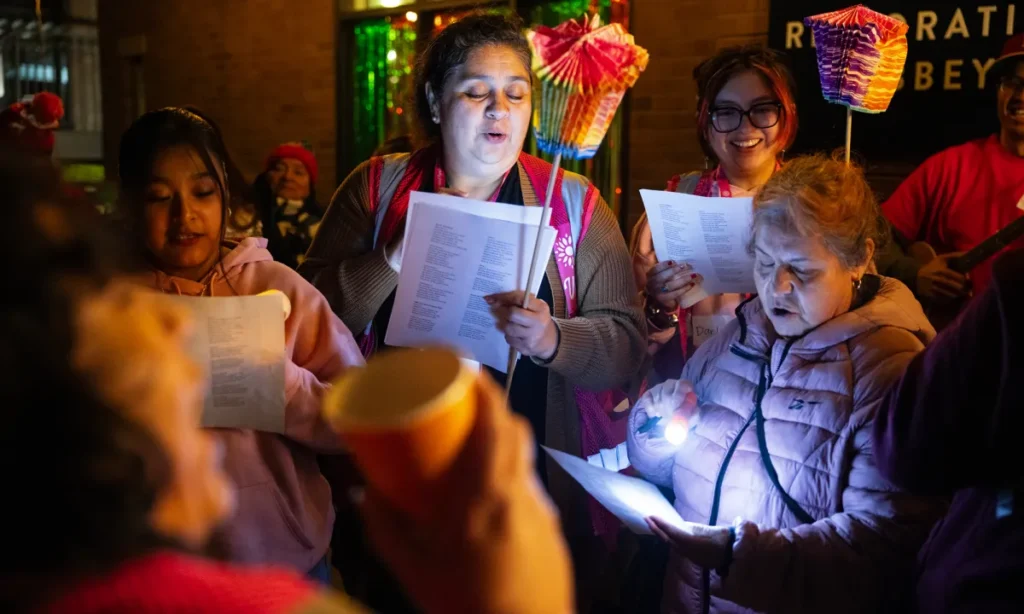Vice President Kamala Harris walks to board Air Force Two in Morrisville, N.C., on Friday, Aug. 16, 2024. Harris used her first major policy speech to unveil the central planks of her economic agenda. (Erin Schaff/The New York Times)

- Kamala Harris proposed an "opportunity economy" to lower costs, boost economic security, and support middle-class Americans.
- Harris contrasted her forward-looking economic vision with Trump's focus on the past, emphasizing different approaches to economic policy.
- Trump criticized Harris' policies as left-wing, accusing her of promoting a "communist" agenda and warning of potential negative impacts.
Share
|
Getting your Trinity Audio player ready...
|
RALEIGH, N.C. — Vice President Kamala Harris unspooled her economic agenda Friday in her first major policy address, casting her vision as one for the future and former President Donald Trump’s as of the past, as she argued that she would improve the lives of middle-class Americans and benefit generations of their descendants.
Harris Paints Herself Different Than Trump
In a roughly 30-minute speech in Raleigh, North Carolina, she painted a sharp contrast between herself and Trump, who has spent more time attacking President Joe Biden’s economic policies than laying out his own.
“This election, I do strongly believe, is about two very different visions for our nation,” Harris said. “One — ours — focused on the future and the other focused on the past. We see that contrast clearly in many ways, including when it comes to how we think about the economy.”
The speech reflected her fight with Trump over how to frame the economic debate in the election. While she tries to make it a choice between competing policy agendas, with diverging possible effects on workers, families and the nation’s economic health, Trump has tried to present the issue as a referendum on the economic stewardship of Harris and Biden. Trump has focused particularly on the surge of inflation on the Biden administration’s watch.
In her speech, Harris emphasized middle-class Americans’ everyday experiences, like sitting at the kitchen table paying their bills or browsing grocery store shelves. She detailed how she would build what she called an “opportunity economy” that would lower the cost of living, provide economic security and remove barriers to building generational wealth.
“As president, I will be laser-focused on creating opportunities for the middle class that advance their economic security, stability and dignity,” she said as she ticked through an economic policy plan released by her campaign Friday.
Related Story: What 9 Cases From Kamala Harris’ Past Say About Her Record as a CA ...
Biden Struggled Where Harris Thrives
Harris’ speech put on display her efforts to unpack policy by personalizing its impact. As Biden struggled to communicate his legislative accomplishments over the past two years, she increasingly became a key messenger for the administration on domestic policy.
In Raleigh, Harris recounted working at a McDonald’s to earn “spending money” as a young woman, while many of her colleagues tried to support families on paltry wages. And before she discussed her policy plans to lower rents and reduce prices of starter homes, she described watching her mother save for more than a decade to afford their first home.
Harris emphasized the cost of housing as a barrier to economic prosperity. She proposed giving first-time homebuyers up to $25,000 in down payment assistance and called for the construction of 3 million housing units that would be affordable for the middle class.
But she also emphasized the importance of being able to pursue homeownership.
Related Story: US Consumer Sentiment Rises Slightly on Democratic Optimism Over Harris’ ...
“It’s more than a financial transaction,” she said. “It’s so much more than that. It’s more than a house. Homeownership and what that means, it’s a symbol of the pride that comes with hard work. It’s financial security. It represents what you will be able to do for your children.”
Much of Harris’ agenda represents an expansion of policies proposed by Biden in his latest presidential budget and during his reelection campaign.
Those measures would generally require legislation from Congress, no sure thing in a divided nation. And she and her aides have laid out few details of how her administration would pay for the substantial spending increases and tax cuts her plan calls for.
Even before Harris released her policy plan, Trump accused her of promoting a dangerously left-wing agenda — particularly her call for a federal ban on price-gouging on groceries — and tried to tie her to autocrats from Latin America like Nicolás Maduro of Venezuela. A similar strategy proved somewhat effective for Republicans in 2020.
Trump Campaign Calls Harris ‘Comrade Kamala’
On Friday, the Trump campaign called the vice president “Comrade Kamala” and said in a news release that she had gone “full communist.”
Kevin Hassett, who served as chair of the White House Council of Economic Advisers during Trump’s presidency, told reporters Friday that Harris’ plan to curb price-gouging was tantamount to having the government set prices, which he said would lead to the types of “food shortages, and even famine” that had plagued socialist countries.
Hassett also criticized Harris’ economic agenda as a return to left-wing policy positions that she had spent the last several weeks distancing herself from. Harris’ “roll toward the middle is completely over,” he said during a call hosted by the Trump campaign and the Republican National Committee.
He and Trump campaign officials declined to answer questions about Trump’s economic policy proposals, including a blanket tariff of up to 20% on imported goods, which Harris has argued amounts to a tax increase on working families.
Polling has found broad support for bringing down the costs of necessities like food, housing and health care, and progressive groups have cheered Harris’ policies.
Related Story: RFK Jr. Reportedly Seeks Cabinet Position in Potential Harris Administration
Many of Harris’ proposals seemed designed to appeal to working- and middle-class families, younger people and those without generational wealth, who are more likely to be Black or Hispanic, and from rural areas.
Among the measures are a new $6,000 tax credit for parents with a child in the first year of life and a $2,000 cap on out-of-pocket prescription drug costs for all Americans. She is also calling for $40 billion worth of tax incentives for developers who build starter homes, according to economic advisers to her campaign.
Trump’s Focus on Inflation
Trump, for his part, has focused on inflation, contrasting the high prices under Biden and Harris with the relatively low inflation the country experienced when he was president.
Harris, he told reporters in New Jersey on Thursday, “just declared that tackling inflation will be a Day 1 priority. For her, it is going to be Day 1, but Day 1 really for Kamala was 3.5 years ago. Where has she been and why hasn’t she done it?”
He has also sought to minimize the record job gains and strong economic growth under the two Democrats, and to play down the pandemic recession that began at the end of his term.
But instead of fighting Trump directly over whether the administration bears blame for high price growth, Harris has largely cast her economic gaze forward.
She has repeatedly cited economists who warn that Trump’s plans, including his broad tariffs proposal, could reignite an inflation rate that has finally cooled over the last year. On Friday, Harris pointed to Trump’s record of giving tax cuts to the wealthiest Americans.
“I think that if you want to know who someone cares about,” she said, “look who they fight for.”
–
This article originally appeared in The New York Times.
By Erica L. Green, Jim Tankersley and Nicholas Nehamas/Erin Schaff
c. 2024 The New York Times Company
RELATED TOPICS:
Categories

Bow Wow Wow. Bulldogs Head to Snoop Dogg Arizona Bowl


















